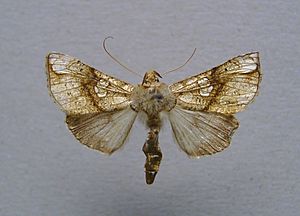Delphinium leaftier facts for kids
Quick facts for kids Delphinium leaftier |
|
|---|---|
 |
|
| Scientific classification | |
| Kingdom: | |
| Phylum: | |
| Class: | |
| Order: | |
| Family: | |
| Genus: |
Polychrysia
|
| Species: |
P. esmeralda
|
| Binomial name | |
| Polychrysia esmeralda (Oberthür, 1880)
|
|
| Synonyms | |
|
|
The delphinium leaftier (scientific name: Polychrysia esmeralda) is a beautiful moth that belongs to a large family of moths called Noctuidae. This moth was first described by a scientist named Charles Oberthür in 1880. You can find the delphinium leaftier in parts of Asia, like eastern Siberia, and across North America, including places like Alaska, British Columbia, and Manitoba.
When they are young, these moths are larvae (caterpillars) and they love to eat plants like monkshood and larkspur, also known as delphinium. Adult moths enjoy drinking nectar from flowers, especially fireweed.
What Does the Delphinium Leaftier Look Like?
Eggs and Larvae
The eggs of the delphinium leaftier are yellow. When they hatch, the young larvae are bright green. These caterpillars move in a special way, like a "looper," which means they arch their bodies as they crawl. Many moths in the Plusiinae group move like this.
Cocoon and Adult Moths
When a larva is fully grown, it gets ready to change into an adult moth. It does this by tying leaves together with silk. Inside this leafy shelter, it spins a cocoon that has a shiny, golden color.
The adult delphinium leaftier moths are very pretty. Their wings have a bright, shining golden color. They look a bit like another moth called Polychrysia moneta. However, the delphinium leaftier has slightly darker wings on top compared to P. moneta. Also, if you look closely at the front wings, the delphinium leaftier has a simple curved line, while P. moneta has a double line.

